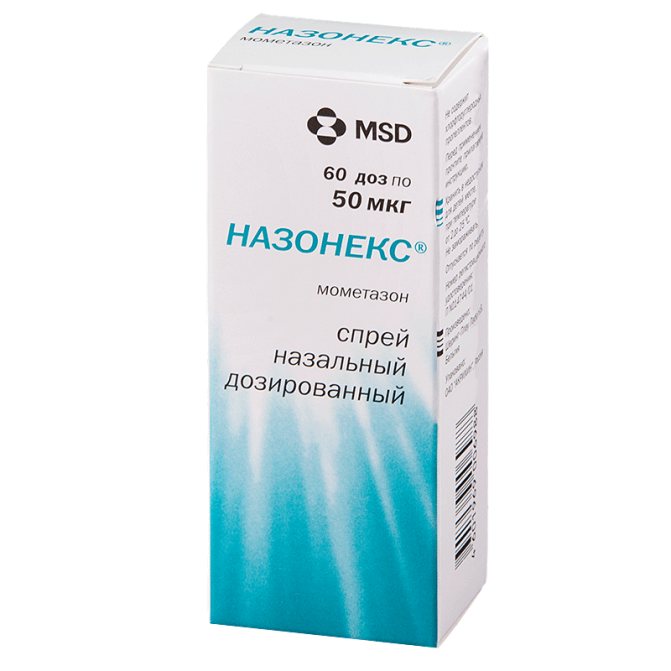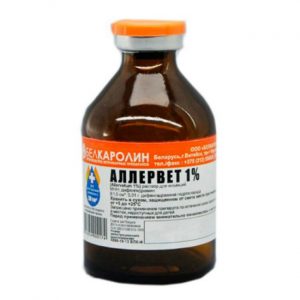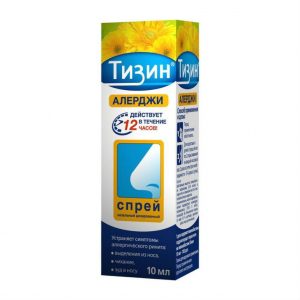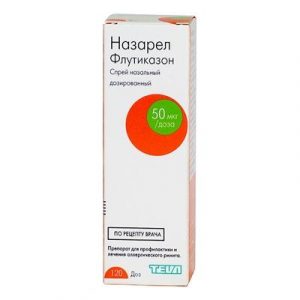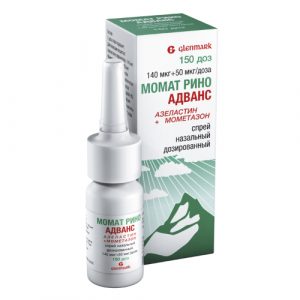Description
Latin name
Nasonex
Release form
Spray nasal
Packaging
Bottle 60 doses.
Pharmacological action
Nazonex – anti-allergic, anti-inflammatory.
Pharmacodynamics
Mometasone furoate is a topical synthetic glucocorticosteroid. It has anti-inflammatory and anti-allergic effects when used in doses at which systemic effects do not occur. It inhibits the release of inflammatory mediators, increases the production of lipomodulin, which is an inhibitor of phospholipase A, which leads to a decrease in the release of arachidonic acid and, accordingly, inhibition of the synthesis of arachidonic acid metabolism products – cyclic endoperoxides, PG. Prevents marginal accumulation of neutrophils, reduces inflammatory exudate and production of lymphokines, inhibits the migration of macrophages, leads to a decrease in the processes of infiltration and granulation. Reduces inflammation by reducing the formation of chemotaxis substance (effect on the late allergy reactions), inhibits the development of an immediate allergic reaction (due to inhibition of the production of arachidonic acid metabolites and a decrease in the release of inflammatory mediators from mast cells).
In studies with provocative tests when applying antigens to the mucous membrane of the nasal cavity, high anti-inflammatory activity of Nazonex was demonstrated both in the early and late stages of the allergic reaction, which was confirmed by a decrease (compared with placebo) in the level of histamine and the activity of eosinophils, as well as a decrease (compared with the initial level) in the number of eosinophils, neutrophils and adhesion proteins of epithelial cells.
Pharmacokinetics of
Mometasone furoat is characterized by a negligible bioavailability ( 0.1%) and when administered as intranasal inhalation, it is practically not detected in blood plasma (even when using the sensitive determination method with a sensitivity threshold of 50 pg / ml). In this regard, the corresponding pharmacokinetic data for this dosage form does not exist. The suspension is very poorly absorbed from the digestive tract, so the small amount that can enter the gastrointestinal tract after inhalation in the nasal cavity, before being excreted in urine or bile, undergoes an active primary metabolism.
Indications
Allergic rhinitis (seasonal or year-round) in adults and children over 12 years of age. Chronic sinusitis (exacerbation, as part of complex therapy).
Contraindications
Hypersensitivity, infectious diseases of the nasal mucosa, recent surgery or nasal trauma (until the wounds heal completely), children (up to 12 years) .C Caution. Tuberculosis (active or latent), fungal, bacterial, systemic viral infections, Herpes simplex with eye damage, long-term therapy with systemic corticosteroids, pregnancy, lactation.
Use during pregnancy and lactation
After intranasal use of the drug at the maximum therapeutic dose, mometasone is not detected in blood plasma even at a minimum concentration, therefore, we can expect that its effect on the fetus will be negligible, and the potential toxicity with respect to reproductive function will be very low.
However, since no special, well-controlled studies of the effect of the drug in pregnant women have been conducted, Nazonex should be prescribed to pregnant women, mothers, breast-feeding women or women of childbearing age only if the expected benefits of its administration justify the potential risk to the fetus and newborn.
Newborns whose mothers used GCS during pregnancy should be carefully examined to identify possible adrenal hypofunction.
Composition
Active ingredient: Mometasone furoate (as monohydrate) 50 mcg
Excipients: dispersed cellulose BP 65 cps glycerol sodium citrate citric acid dihydrate monohydrate polysorbate 80 benzalkonium chloride phenylethyl alcohol purified water.
Side effects
In the treatment of seasonal or perennial allergic rhinitis.
In adults:
nosebleeds (obvious or secretion of stained mucus or blood clots)
pharyngitis,
burning sensation in the nose,
irritation of the nasal mucosa.
Nasal bleeding, as a rule, stopped on their own, were not severe, they occurred with a frequency slightly higher than when using placebo (5%), but equal to or less than when using other GCS for intranasal use, which were used as an active control (in some of them, the incidence of nosebleeds was up to 15%). The frequency of occurrence of all other adverse events was comparable with the frequency of their occurrence with the appointment of a placebo.
In children:
nosebleeds,
headache,
sensation of nose irritation,
sneezing.
The incidence of these adverse events in children was comparable to their incidence with placebo.
In the treatment of exacerbations of sinusitis (when using Nazonex spray as an adjuvant).
In adults and adolescents:
headache,
pharyngitis,
burning sensation in the nose,
irritation of the nasal mucosa.
Nasal bleeding was moderate, the frequency of occurrence with nasonex was also comparable to the frequency of nasal bleeding with placebo (5% compared with 4%, respectively).
Very rarely, with intranasal use of corticosteroids, there have been cases of perforation of the nasal septum or increased intraocular pressure.
Drug Interaction
Combination therapy with loratadine was well tolerated in patients. No interaction studies have been performed with other drugs.
overdose
Symptoms: prolonged use of ACS in high doses, as well as the simultaneous use of several ACS may inhibit the function of the hypothalamic-pituitary-adrenal system.
Treatment: Due to the low (less than 0.1%) systemic bioavailability, it is unlikely that any accidental or deliberate overdose will require any measures other than monitoring the patient with subsequent continued treatment at the recommended dose.
Storage conditions
At 2 25 ° C. (do not freeze)
The Expiration of
is 3 years.
Active ingredient
Mometasone
dosage form
dosage form
nasal spray
Shering-Plow Labo N.V., Belgium
